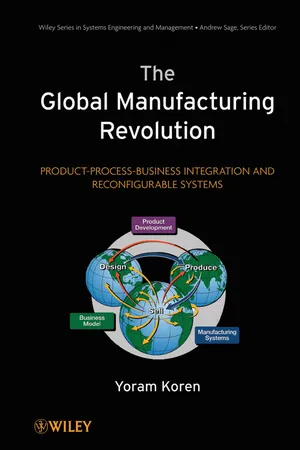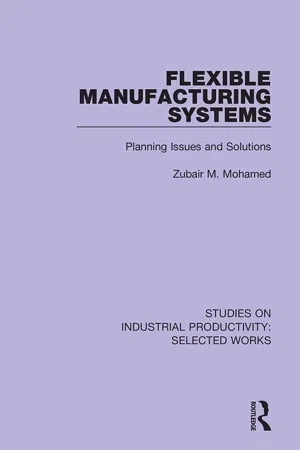Flexible Production
Flexible production refers to the ability of a business to quickly and efficiently adjust its production processes in response to changes in demand, technology, or other factors. This approach allows companies to adapt to market fluctuations, customize products, and minimize waste. By implementing flexible production methods, businesses can enhance their agility and responsiveness to dynamic market conditions.
3 Key excerpts on "Flexible Production"
- eBook - ePub
- Philip Cooke(Author)
- 2015(Publication Date)
- Routledge(Publisher)
...Technological flexibility or, to use an even more relevant term, productive flexibility, can in very general terms be defined as the capacity of a productive system to adapt itself at the lowest cost to different contingencies, in particular to both quantitative and qualitative variations in demand. Flexible Production systems would have: (a) as a final objective: improved product quality and diversity, batch production, the development of supply-chains for goods and services, adaptation of products to the specific needs of users, with a particular dominance of small- and medium-sized batch production; and (b) as a means of implementation: the establishment of new forms of production and management based on new capital equipment, computerized information systems, communication systems, programmable automation, and new forms of organization which can be implemented at several levels (production lines, production units, units of firms or groups of firms). The purpose of this argument is not to analyse this flexible model and its variations. Still, we want to focus on some questions concerning its content and consequences. Today, the search for flexibility presents itself as a major preoccupation at several levels and modes of organization of production. It includes organizational forms that move beyond multidivisional or static matrix structures, the push towards externalization, as well as network relationships between enterprises, the functioning of the labour market, and the transformation of regulatory structures. This widespread use of the concept of flexibility stresses the centrality of the transformation of productive structures. But, at the same time, it gives a multidimensional content to this notion. As such, it makes precarious the analysis of its content and consequences...
- eBook - ePub
The Global Manufacturing Revolution
Product-Process-Business Integration and Reconfigurable Systems
- Yoram Koren(Author)
- 2010(Publication Date)
- Wiley(Publisher)
...The challenge is to reconfigure manufacturing enterprises rapidly in response to changing needs and opportunities. Reconfiguration could involve multiple organizations, a single organization, or the production/process floor of a single organization. The driving factors for reconfigurable enterprises are rapidly changing customer needs; rapid changing market opportunities; and development in process, product, and electronic communications technology.” Rapid responsiveness is crucial to the success of the global manufacturing enterprise in these rapidly changing global market conditions. The product design process must be quick and integrated with the manufacturing system that will produce it, as well as the business strategy that coordinates the supply of products at the right quantities to the right customers. Possessing a flexible system is necessary, but insufficient to compete globally, where the speed of responsiveness to new market conditions creates an opportunity for competitive advantage. Possessing reconfigurable manufacturing systems enables companies to increase their responsiveness because these systems can quickly adjust their production capacity (i.e., volume per product) to match market demand and can be rapidly tooled to produce new products. The reconfigurable manufacturing systems, therefore, provide… …exactly the capacity and functionality needed, exactly when needed 14.3 I—Integration of Product, Process, and Business A critical factor in sustaining company growth and rapidly responding to market opportunities is the integration of the three basic functions of the manufacturing enterprise: Design products by product development teams Make products on manufacturing systems Sell products by utilizing business strategies. Traditionally, the marketing, product design, and manufacturing units work successively on the development of new products (Figure 14.3a)...
- eBook - ePub
Flexible Manufacturing Systems
Planning Issues and Solutions
- Zubair M. Mohamed(Author)
- 2018(Publication Date)
- Routledge(Publisher)
...I Flexible Manufacturing Systems 1.1 INTRODUCTION International and domestic competition coupled with changing customer needs and shorter product life cycles are requiring U.S. manufacturers to overhaul their operations. Firms must react to market changes quickly with better quality products at low cost. To cope with this new environment, U.S. manufacturers are installing Computer Integrated Manufacturing (CIM) systems. A Flexible Manufacturing System (FMS) is an important component of CIM. A typical FMS consists of a group of Numerical Control (NC) machine tools connected by an automated material handling system (MHS) under the guidance of a central supervisory computer. These systems emulate the flexibility of job shops while retaining the efficiency of dedicated production lines. The versatility of NC machines enables the system to react quickly and economically to changing requirements. These systems increase productivity by reducing inventory and throughput time. As shown in Figure 1.1, flexible manufacturing systems have been developed to serve the middle ground of batch manufacturing where part variety is too low for dedicated processes but too high for stand alone machine tools. Chang, Wysk, and Wang (1991) have found that today over 90% of production is manufactured in lots of less than 50 parts. FMS concepts are also used in a variety of other automated processes. These include: assembly, metal forming, painting, and sheet metal operations. Barash (1978) found that the number of flexible manufacturing systems is growing at a rapid rate (estimated to be 5,000 by the year 2000). The actual number of flexible manufacturing systems installed worldwide as of 1990 are at least 1200 (Ayers et al. 1991). These numbers are expected to double every two or three years in the future. Figure 1.1: Production Systems Application Areas Currently, there isn’t any universally accepted definition of an FMS. Several studies have defined it in different ways...


